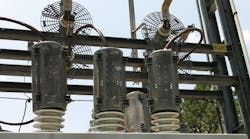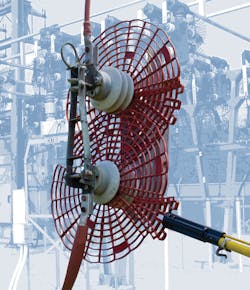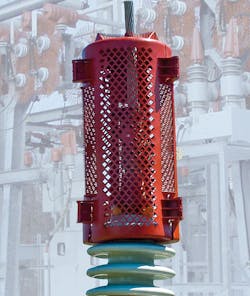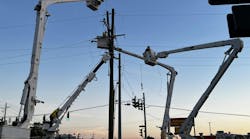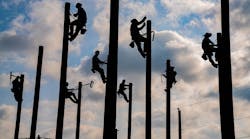Critters are sneaking into Georgia Power’s substations, putting themselves at risk of electrocution and the utility’s customers at risk for power outages.
For example, when birds make a nest inside a substation, snakes come slithering through the fence in search of eggs. At the same time, squirrels are scurrying across the power lines and using them as highways through the substation. Squirrels are determined to go from one point to the next no matter what is in front of them. They often travel from the power lines, over the fence, across the switch to the buswork. If they step from a grounded part to an energized part, however, they can make contact with their tail and paws, causing a short.
Osprey, eagles and hawks are perching on power lines along the utility’s rights-of-way. Smaller sparrows and birds are also walking across the lines with their feet very close together. The problem occurs, however, when they take off for flight. If they have a 2-ft to 3-ft wingspan and reach from one phase to another phase wire, they can cause a short in the circuit, leading to a power outage.
Causing Trouble
Another problem with the birds perching on power lines and structures is that when they build their nests, their waste can build up on the equipment on the lines or insulators. The excrement then allows the electricity to “track,” which leads to a fault and interruption of service.
Inside substations, birds can hop onto switches or buswork. Snakes and raccoons have also slipped into substations looking for small game.
Each substation has lines that come in and out of them to form circuits. When any animal — whether it’s a snake, bird, raccoon or squirrel — reaches from any grounded part to an energized part, it causes a ground fault. If the animal is blown clear of the equipment and killed, then the lights may flicker but power will stay on for the customers. If the fault can’t be cleared and the animal is stuck in the path of the current, then control logic will lock the circuit out.
Deterring Unwelcome Animals
For many years, the utility has tried to find ways to keep squirrels, raccoons, snakes and birds off the switches and lines, and prevent them from bridging the gap from phase to ground. The utility couldn’t put metal guards or shields over electric pieces of equipment, so it cut disks out of a plastic called Lexan and placed them over the insulators to force animals to safely pass over them.
Another strategy that Georgia Power tried was sticking an inflatable owl inside the substation yard. This method proved to be ineffective.
While the owls did not serve as an effective deterrent, Georgia Power did find one way to help keep snakes out of the substation. Georgia Power sprinkled a product called Scratch and Sniff, a granular material made up of ground up newspaper and other products, around the perimeter fence surrounding one substation. The utility found that the snakes didn’t like the smell or feel of the material and avoided contact with it. So far, the utility has only used the product once in an experimental application, but for that particular situation, it seemed to help with the snake problem.
Discovering Ways to Protect Wildlife
After years of being frustrated by animal-related events, Georgia Power began working with Raychem (now known as TE Connectivity) to develop a solution back in the 1990s. In fact, the company was the first utility to work with the vendor on protecting wildlife inside substations.
By working closely with TE Connectivity, the utility devised an effective way to cover up the exposed connections. The utility and manufacturer developed a cover-up, which the utility installs out in the field and then adapts it as necessary.
For example, Georgia Power used to rely on a heat-shrink wrap that slips over the line. The field workers would then use a torch to shrink it down. For the last year, however, the utility has used a wrap with an overlapping split. By taking the material and slipping it over the conductor, the utility employees don’t have to break connection points. As a result, it requires less labor to install it and it doesn’t require a torch.
The utility also now uses bushing covers to cover up the connectors. The bushing cover is a ventilated checkerboard pattern that you can see through. It’s like a small version of a screen door, made out of a hard molded plastic material.
Georgia Power also installs a round disk that can fit around the insulators. This disk, which measures 2 ft to 3 ft, prevents animals from reaching from a grounded part to an energized part and insulates them from electrocuting themselves.
By shortening their reach, they can’t make contact across an energized part and a grounded part simultaneously. By stepping up and over the cover, the squirrel will be completely off the steel structure when it reaches out for its next step.
The disks are easier to use and maintain, and they have a longer life than the former cover-ups made from Lexan. Georgia Power discovered that the UV rays rapidly aged the Lexan, causing it to split, crack and fall off. The crosslinked polymer material from TE Connectivity, however, lasts much longer than the plastic. Case in point: The utility decommissioned a substation with original materials from 20 years ago, and it was still in place and still doing its job.
Installing Cover-ups at Substations
To prioritize where the wildlife protection products need to be installed, Georgia Power keeps close track of when and why outages have occurred. If one particular substation has had multiple animal-caused outages, the utility focuses on covering up that substation. Like other utilities, Georgia Power looks for trends and patterns when deciding when and where to install the cover-up products.
The utility relies on its internal construction crews and its maintenance crews to install the disks, bushing covers and line covers. In most cases, the workers install the covers on a de-energized line or circuit. The safest way to install the materials is when everything is de-energized and grounded. That way, they can work on it with bare hands, clip, snap or slip the material in place, and then re-energize the line or circuit. While they can reposition it while the equipment is still hot, they prefer to do it during an outage. When necessary, they will install the product with a hot stick, but this makes it much harder for them to do precise work like turning a clip.
Other companies manufacture products that can be brushed or sprayed on, which makes a hard coating over the equipment. These manufacturers often bring the material to the site, put it in place, and it can never be taken off. The benefit of the Raychem cover-ups, however, is that if the construction and maintenance crew members need to work on a particular piece of equipment, they can take the cover off, make their repairs and then reinstall the covers. The split wrap is made of a soft polycarbonate material, which is pliable, easy to use, and able to be re-used and repositioned as necessary.
To ensure consistency with the installation, Southern Company created a standard for all of its operating companies including Georgia Power. The company created a series of special safety and installation videos so each crew understands how the products go on, the benefits of each product and how to remove them in a safe manner. While the installation is intuitive after a few times, it’s essential for each company to install the covers in the same way.
By installing the cover-ups, Georgia Power has minimized its number of animal-induced outages. After the utility installs the materials in a substation, it sees exactly what it is supposed to do. If it’s not alleviating the problem, then the utility may need to adjust the fence or lower an entrance gate to make it especially tight around the perimeter. Through a combination of solutions, the utility is able to confront the problem of animal-caused outages while protecting wildlife and limiting the interruptions to the customers.
Steven McCarley ([email protected]) is a senior substation designer and a special projects engineer for Southern Company. He has been with the company for 32 years and is responsible for resolving issues and concerns in the substation yards, including that of animal-induced outages at substations. He is also the lead product engineer for control houses for the Southern Company.
Companies mentioned:
Georgia Power| www.georgiapower.com
Southern Company| www.southerncompany.com
TE Connectivity| www.te.com
